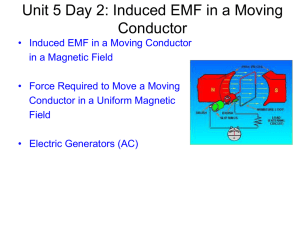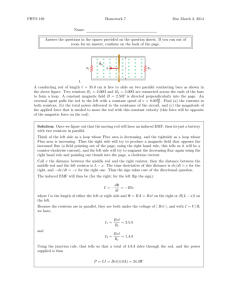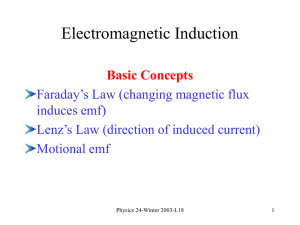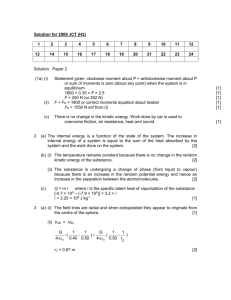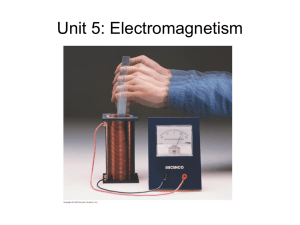Physics 111 Fall 2007 Faraday's Law Solutions
advertisement
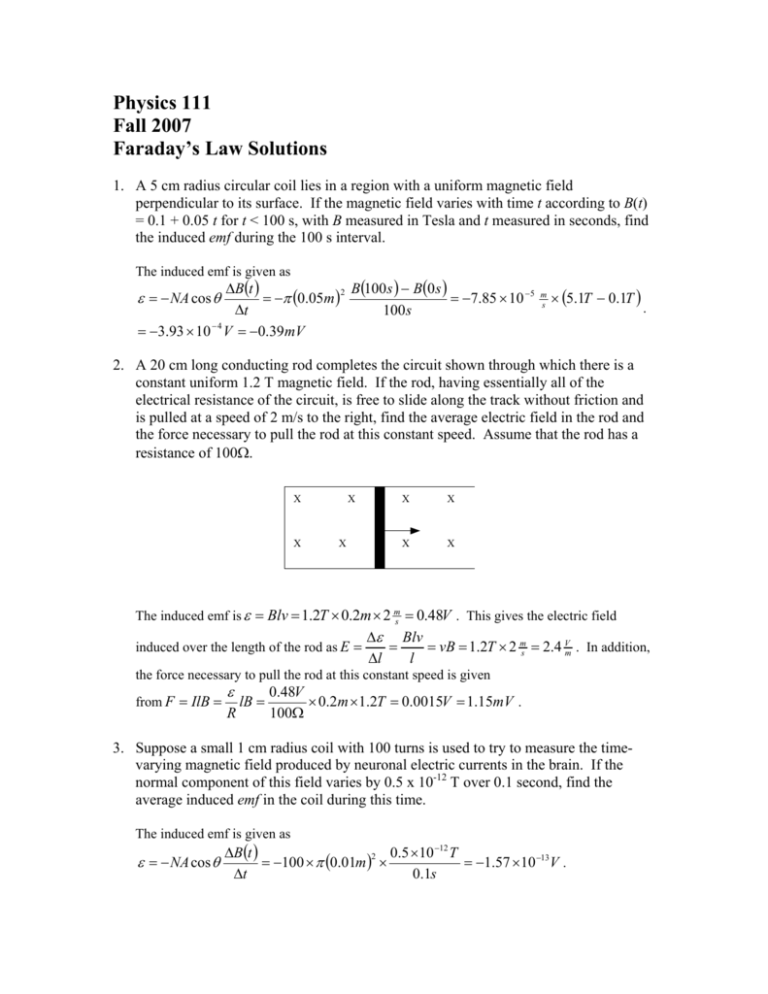
Physics 111 Fall 2007 Faraday’s Law Solutions 1. A 5 cm radius circular coil lies in a region with a uniform magnetic field perpendicular to its surface. If the magnetic field varies with time t according to B(t) = 0.1 + 0.05 t for t < 100 s, with B measured in Tesla and t measured in seconds, find the induced emf during the 100 s interval. The induced emf is given as ∆B(t ) 2 B (100 s ) − B (0 s ) = −π (0.05m ) = −7.85 × 10 −5 ∆t 100 s = −3.93 × 10 − 4 V = −0.39mV ε = − NA cos θ m s × (5.1T − 0.1T ) . 2. A 20 cm long conducting rod completes the circuit shown through which there is a constant uniform 1.2 T magnetic field. If the rod, having essentially all of the electrical resistance of the circuit, is free to slide along the track without friction and is pulled at a speed of 2 m/s to the right, find the average electric field in the rod and the force necessary to pull the rod at this constant speed. Assume that the rod has a resistance of 100Ω. X X X X X X X X The induced emf is ε = Blv = 1.2T × 0.2m × 2 ms = 0.48V . This gives the electric field induced over the length of the rod as E = ∆ε Blv = = vB = 1.2T × 2 ms = 2.4 Vm . In addition, ∆l l the force necessary to pull the rod at this constant speed is given from F = IlB = ε R lB = 0.48V × 0.2m ×1.2T = 0.0015V = 1.15mV . 100Ω 3. Suppose a small 1 cm radius coil with 100 turns is used to try to measure the timevarying magnetic field produced by neuronal electric currents in the brain. If the normal component of this field varies by 0.5 x 10-12 T over 0.1 second, find the average induced emf in the coil during this time. The induced emf is given as ε = − NA cos θ ∆B (t ) 0.5 × 10 −12 T 2 = −100 × π (0.01m ) × = −1.57 × 10 −13V . ∆t 0.1s 4. A long straight wire lying along the x-axis carries a constant 5 A current along the positive x direction. A small 5 mm diameter loop lies in the x-y plane centered at y = 2 m. If the loop is suddenly stretched so that its area shrinks to zero in 0.2 seconds, find the average induced emf in the coil assuming the B field is constant over its area. Draw a sketch showing the direction of the induced current. The induced emf is given as ( ) π 2.5 ×10−3 m ∆B(t ) 2 ε = − NA cos θ = −100 × 5 ×10 −17 Tπ (0.01m ) × = −4.91×10 −11V , ∆t 0.2 s µ I 4π × 10 −7 TmA × 5 A where the magnetic field is calculated from B = o = = 5 × 10 −7 T for a 2πr 2π × 2m 2 long straight wire. 5. Give an order of magnitude estimate, based on Faraday’s law, of the induced emf detected by a search coil with a 0.2 m diameter 1 cm away from a long neuron which carries an average current of 10 pA switched on in 1 ms. The induced emf estimate is 4π × 10 −7 Tm µ ∆B (t ) ∆I 10 × 10 −12 A 2 2 A = πrcoil × o × = π (0.1m ) × × ∆t 2πr ∆t 2π × 0.01m 1 × 10 −3 s ≈ 5 × 10 −15 V ≈ 1 × 10 −14 V ε = − NA cos θ 6. A 4 mm diameter circular coil of 25 turns lies in the x-y plane at a distance of 3 m from a long straight current-carrying wire. If the current in the wire is increasing at a rate of 0.2 A/s, find the induced current in the coil and give its direction in a sketch. (Assume the magnetic flux is uniform over the area of the coil.) The induced emf is given as ε = − NA (( µ ∆B ∆I = − NA × 0 × = −25 × π 2 × 10 −3 m ∆t 2πr ∆t ) )× 4π2π×10 × 3m 2 −7 Tm A × 0.2 As = 4.1× 10 −12 V which is used to calculate the induced current from Ohm’s Law. The induced current is ε 4.1× 10 −12 V therefore ε = IR → I = = = 4.1× 10 −9 A = 4.1nA . −3 R 1× 10 Ω 7. Induced emf measurements can be used to measure the speed of a conducting fluid such as sea water. If a 20 cm inner diameter non-conducting pipe has sea water flowing through it at a flow rate of 10 gallons per minute and a uniform magnetic field of 0.05 T is applied transversely across the pipe, find the induced emf across a diameter. The induced emf is given as ε = Blv and the velocity of the fluid needs to be calculated. To calculate the fluid velocity we use the equation of continuity, which relates the flow rate to the area of the pipe and the velocity of the fluid in the pipe. The flow rate is 10 gallons min v fluid 1 min 0.0378m 3 × × = 6.3 × 10 − 4 60 sec 1gallon 6.3 × 10 − 4 = Apipe m3 s m3 s = Apipe v fluid 6.3 × 10 − 4 ms = = 0.02 ms π (0.1m )2 3 . −4 Thus the emf is ε = Blv = 0.05T × 0.2m × 0.02 ms = 2.0 ×10 V = 0.2mV . 8. A helicopter has blades of length 3.00 m, extending out from a central hub and rotating at 2.00 rev/s. If the vertical component of the Earth’s magnetic field is 50.0 µT, what is the emf induced between the blade tip and the center hub? The induced emf is calculated from the angular velocity ω = (2.00 rev s )(2π rad rev ) = 4.00π rad s ε = 1 Bω l 2 = 2 2.83 m V 9. Strong magnetic fields are used in such medical procedures as magnetic resonance imaging. A technician wearing a brass bracelet enclosing area 0.005 00 m2 places her hand in a solenoid whose magnetic field is 5.00 T directed perpendicular to the plane of the bracelet. The electrical resistance around the circumference of the bracelet is 0.020 0 Ω. An unexpected power failure causes the field to drop to 1.50 T in a time of 20.0 ms. Find (a) the current induced in the bracelet and (b) the power delivered to the bracelet. (Note: As this problem implies, you should not wear any metal objects when working in regions of strong magnetic fields. In addition, when in a MRI you should take care not to have any objects form a closed loop with your body. From Faraday’s Law, a current will be induced in the object and will pass through you. This can happen for example with an IV cord.) ε = −N 1.50 T − 5.00 T ⎞ ∆ ∆B (BA cos θ ) = −N π r 2 cos 0° = −1 0.005 00 m 2 (1)⎛⎜⎝ ⎟ = 0.875 V ∆t ∆t 20.0 × 10−3 s ⎠ ( ) ε = ( 0.875 V = 43.8 A 0.020 0 Ω (a) I= (b) P = ε I = (0.875 V )(43.8 A ) = 38.3 W R ) 10. To monitor the breathing of a hospital patient, a thin belt is girded around the patient’s chest. The belt is a 200-turn coil. When the patient inhales, the area encircled by the coil increases by 39.0 cm2. The magnitude of the Earth’s magnetic field is 50.0 µT and makes an angle of 28.0° with the plane of the coil. Assuming that a patient takes 1.80 s to inhale, find the average induced emf in the coil during this time. ε = −N dΦB d = −N (BA cos θ ) dt dt ⎛ ⎝ ∆t ⎠ ⎝ −4 m2 ⎞ ⎟⎠ = −10.2 µ V 1.80 s ε = −N B cos θ ⎛⎜ ∆A ⎞⎟ = −200 (50.0 × 10−6 T )(cos 62.0° )⎜ 39.0 × 10


